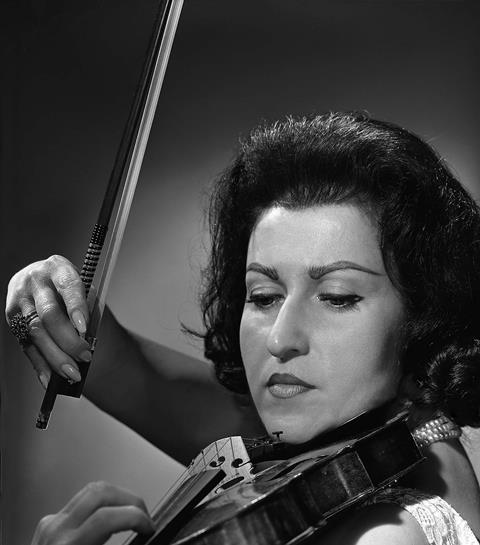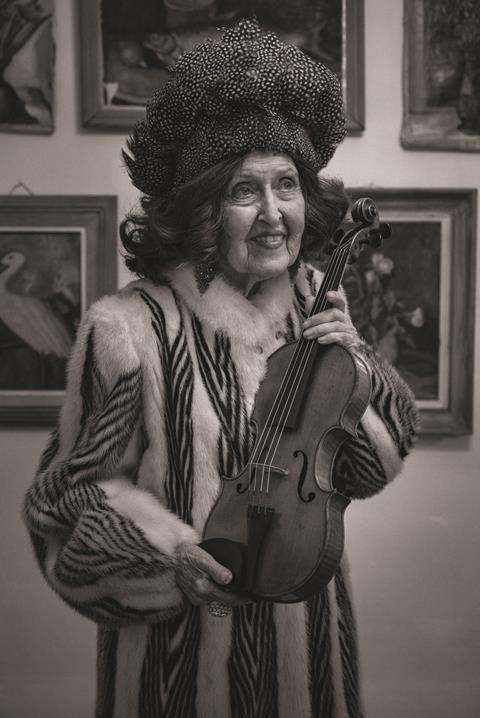Following Ida Haendel’s death at the age of 96 in July 2020, Tully Potter surveys the career of an exceptional performer and a remarkable woman. From September 2020

Discover more Featured Stories like this in The Strad Playing Hub
When Ida Haendel died on 1 July, aged 96, we lost almost the last survivor from Carl Flesch’s famous 1930s class – only Ivry Gitlis is left now. Like him, Haendel had a rather unorthodox career, not helped in her case by some quixotic decisions.
Born Ida Hendel in Chelm, eastern Poland, on 15 December 1923, at three she picked up her sister’s violin and played a song her mother had been singing. Her father Natan, whose progress as a cellist had been frustrated by his own father, a rabbi, became the archetypal prodigy-pushing parent. When Ida was six the family moved to Warsaw, where she studied with Mieczysław Michałowicz (a pupil of Stanisław Barcewicz and Leopold Auer) who also taught Szymon Goldberg, Roman Totenberg and Josef Hassid. In her outspoken memoirs, Woman with Violin, she denigrated Michałowicz but he clearly gave her a good start. She won a gold medal at nine and the Huberman Prize at ten, and came seventh in the first Wieniawski Competition. She made her Warsaw Philharmonic debut with Mozart’s A major.
Sponsored to study with Joseph Szigeti in Paris, Ida found his schedule too busy, so turned to Carl Flesch. Although there were ructions between Natan Hendel and the master – especially when Natan took Ida to George Enescu for a different viewpoint – she followed Flesch to London, becoming ‘Haendel’, and stayed with him until 1939, when she took British citizenship. By then she was hugely popular with audiences here, especially at the Proms, where she would go on to appear 68 times; and she was one of those who bolstered British spirits throughout the war, playing in factories, at the National Gallery and for the troops.
Flesch’s system was geared towards producing soloists and Haendel was an extreme case. There was no Haendel Trio or Quartet. Nor was she a natural collaborator: she never played the Beethoven ‘Triple’, and rarely blew the dust off her copies of the Bach or Brahms ’Doubles’, although she enjoyed playing Mozart’s Sinfonia concertante with her pupil David Garrett. She liked working with accompanists rather than pianists of her own stature, but late in life was sometimes partnered by Ronald Turini or Vladimir Ashkenazy. Favoured sonatas were one by Mozart, three by Beethoven, two by Brahms, the Franck, Bartók’s Second and Enescu’s Third. She often performed Bach’s Chaconne and more rarely his G minor Sonata. She liked Baroque transcriptions, Sarasate’s Zigeunerweisen, Szymanowski’s Mythes, Chausson’s Poème, Bartók’s Rhapsody no.1, Ravel’s Tzigane and Stravinsky’s Divertimento.
Deprived of a normal development – ‘I was never a child!’ she says in Paul Cohen’s 2004 documentary – and dominated by her father, she never established a regular relationship with a man, although she admitted to a crush on the conductor Sergiu Celibidache. In 1952 she moved to Montreal: it seemed strange to cut herself off from the one audience for whom she was a household name. ‘I was brought up in Britain and regard myself as British,’ she later told a UK journalist, ‘but they really have no regard for you if you live here.’ She retained a London apartment and never took root in North America, despite appearing there from 1946. She was much better loved in Israel, which she first visited in 1947 when it was still Palestine. She was always welcomed in the Netherlands and had a good reputation across much of Europe. From 1957 she visited Prague, making some of her best recordings there.

Perhaps in compensation for her lost childhood, the diminutive Haendel often dressed outrageously, appearing on the concert platform in girlish frills and stiletto heels long after such garb was commonplace; and in the late 1960s she suddenly took five years off her age, forgetting what a nonsense it made of her early years and how much evidence there was for her true birthdate. It had an effect precisely opposite to that which she intended, making her age an issue with the media.

In concertos she ruled supreme among female players, especially after the death of her classmate Ginette Neveu. Early on, she regularly surprised Prommers with a ‘new’ concerto, moving on from her warhorses the Beethoven – which she played well without fully penetrating its mysteries – and the Brahms (a better fit with her) to Mendelssohn (1939), Tchaikovsky and Dvořák (1941), Elgar (1942), Lalo’s Symphonie espagnole (1943), Mozart D major K218 (1946), and Sibelius (1949). She treasured Sibelius’s note after a 1948 Finnish Radio rendition – ‘You played it masterfully in every respect … I congratulate myself that my concerto has found an interpreter of your rare standard’ – unaware that he said similar things to other violinists. She also played Khachaturian, Wieniawski (no.2), Bruch (no.1), Britten, Walton, Casella (hard to memorise, she said), Bloch, Bartók (the Second) and Dallapiccola’s Tartiniana Seconda. No intellectual or philosopher in my opinion, she could still sustain the lengthy Elgar and Reger – and the concerto which she premiered by Allan Pettersson, a single span lasting close to an hour.
Her playing ranged from the tonally pure to the gutsy and vibrant, always with a hint of portamento. It is preserved on fewer records than she merited: she left it rather late to record Bach’s Sonatas and Partitas. Her tone is well displayed on a 1976 disc of gloriously inauthentic Baroque transcriptions. Many associate her with the Sibelius but I find her vibrato overdone in the Adagio, preferring the more ‘inward’ approach of another Flesch pupil, Anja Ignatius. The 1953 Brahms with Celibidache and the 1977 Britten and Walton with Paavo Berglund are classics. Doremi’s series has excellent live material, including Brahms, Enescu and Franck with Turini.
She used a 1696 Strad for almost 60 years, having previously borrowed the 1726 ‘Sleeping Beauty’ Strad. ‘Before that I had a German imitation of a Guarnerius and no one knew the difference,’ she said. Her favourite bow was a Hill Fleur de Lys. Even at a great age she could impress. In a late Wigmore Hall recital, her intonation was slightly off throughout the programme; then, in the encores, she played a favourite solo transcription from Swan Lake dead in tune.
Read: ‘We must be aware of our choices’ - violinist Jennifer Koh’s life lessons
Read: Masterclass: Schubert Fantasy for violin and piano – part one
Discover more Featured Stories like this in The Strad Playing Hub
The number one source for playing and teaching books, guides, CDs, calendars and back issues of the magazine.
In The Best of Technique you’ll discover the top playing tips of the world’s leading string players and teachers. It’s packed full of exercises for students, plus examples from the standard repertoire to show you how to integrate the technique into your playing.
The Strad’s Masterclass series brings together the finest string players with some of the greatest string works ever written. Always one of our most popular sections, Masterclass has been an invaluable aid to aspiring soloists, chamber musicians and string teachers since the 1990s.
American collector David L. Fulton amassed one of the 20th century’s finest collections of stringed instruments. This year’s calendar pays tribute to some of these priceless treasures, including Yehudi Menuhin’s celebrated ‘Lord Wilton’ Guarneri, the Carlo Bergonzi once played by Fritz Kreisler, and four instruments by Antonio Stradivari.













































No comments yet